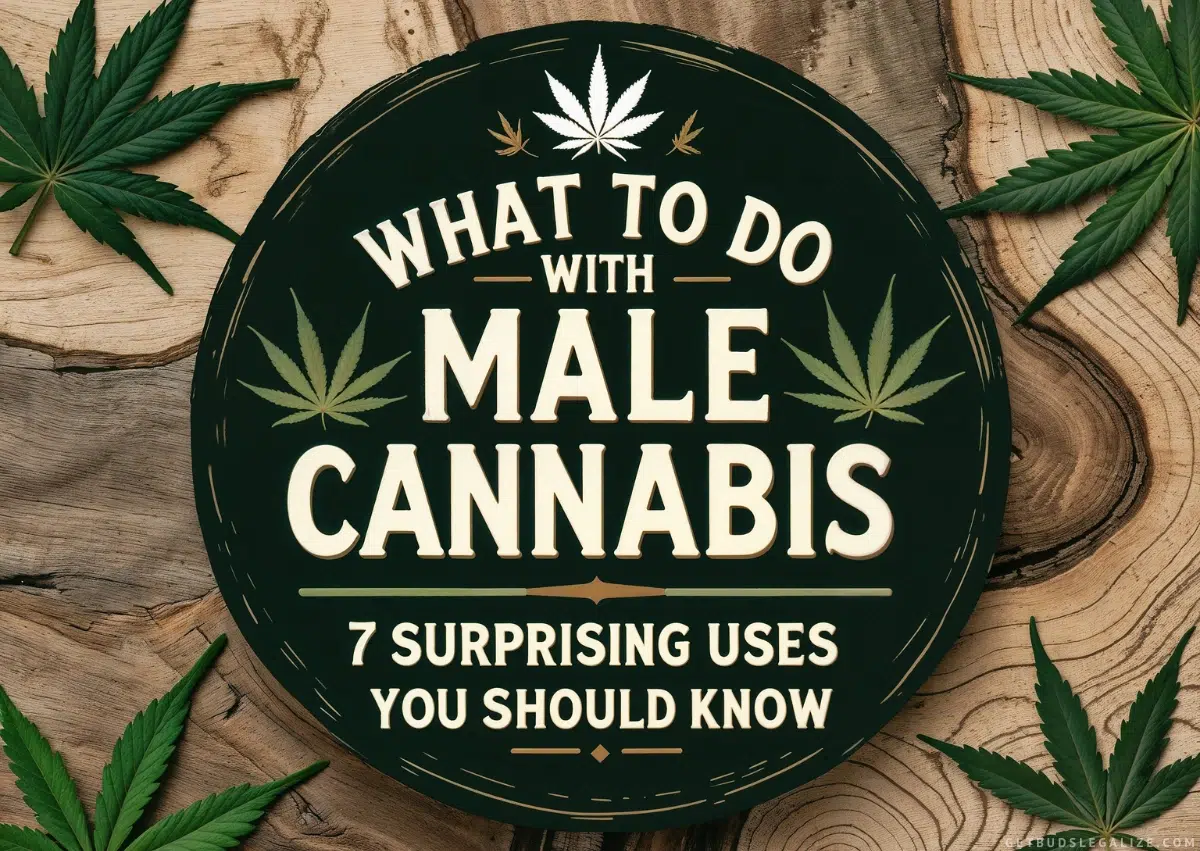What to Do with Male Cannabis Plants: 7 Surprising Uses



What to Do with Male Cannabis Plants: 7 Surprising Uses You Should Know
Most cannabis growers discard male plants early in the growing process, especially now that feminized seeds are so widely available. In many indoor growing rooms, male plants are removed before they even have a chance to thrive.
However, these often-overlooked plants have a surprising array of uses beyond their primary role in seed production. In this article, we’ll explore how male cannabis plants contribute to breeding programs, concentrate production, textiles, and much more.
1. Harnessing the Power of Male Cannabis in BreedingMale cannabis plants play a crucial role in breeding programs by contributing half of the genetic material needed for the next generation. By selecting strong, healthy males with desirable traits, breeders can help pass those traits onto offspring, ensuring improved resilience and diversity in the crop.
What to Look for in a Good Male:
- Growth Rate: Fast-growing males help ensure vigorous offspring.- Health and Resistance: Males who show resistance to pests, mold, and diseases are valuable assets in breeding.
- Hermaphroditism Prevention: Males with stable genetics help reduce the risk of hermaphroditic plants (those that produce both male and female flowers).
- Potency and Flavor: Although harder to measure, experienced breeders can detect subtle clues in aroma or flower structure that indicate desirable traits in offspring.
In breeding programs, male plants also play an important role in crossing autoflowering strains. They contribute to passing on growth patterns while maintaining the potency and flavor profile of the female plants. Breeding often involves crossing identical female clones with multiple males to compare results and select the males that produce the highest-quality offspring.
While the direct correlation between a male’s potency and the potency of its female offspring is still debated, breeders often observe early signs of these traits during the flowering period. Techniques like pinching flowers to release aroma can provide valuable insight into potential outcomes.



2. Can Male Cannabis Plants Pack a Potent Punch? Debunking the Myth
A common misconception is that male cannabis plants lack significant amounts of cannabinoids like THC and CBD. While female plants generally contain higher levels of cannabinoids, male plants do not come up empty-handed. Research conducted in 1971 found that male cannabis plants still exhibited measurable THC and CBD content.
Key Findings:
- Male cannabis plants do contain THC and CBD, albeit in lower quantities than females.- Some male plants, such as the Hizzine 3.9.1969 variety, exhibited higher THC levels than their female counterparts.
- Males from Thai landrace varieties showed THC content between 0.7% and 0.8%, which is comparable to some female plants.
Although male plants tend to produce less resin, they still play a valuable role in breeding strong, resilient strains.
While male plants are not as potent as females, they are still valuable for creating strains with desirable genetic traits. Their cannabinoid content may not be ideal for recreational use, but they offer a unique, uplifting effect for those seeking something different.
3. Unveiling the Evolutionary Advantages of Male Cannabis PlantsCannabis, like many species in the Cannabaceae family, is dioecious—meaning male and female plants are separate. This is relatively rare in the plant kingdom, as over 80% of flowering plants are hermaphroditic, with both male and female reproductive organs on the same plant.
Dioecy (separate male and female plants) offers a selective advantage by promoting genetic diversity. In monoecious or hermaphroditic plants, self-pollination can lead to inbreeding, which weakens genetic diversity.
Dioecious plants, on the other hand, cross-pollinate, leading to stronger, more resilient offspring.
While cannabis can occasionally produce hermaphroditic plants—especially under stress—the presence of strong male plants ensures genetic variation, vital for the species' long-term survival.


4. Male Cannabis: The Secret to Sustainable Textiles
Male hemp plants, in particular, are prized for their fine, soft fibers. In a 1996 study from Hungary, researchers found that male hemp fibers are finer and more flexible than those of female plants, making them ideal for creating high-quality textiles like tablecloths, towels, and bed linens.
Properties of Male Hemp Fibers:
- Fineness and Softness: Male hemp fibers are softer and finer than female fibers, making them perfect for high-end fabrics.- Flexibility: Male fibers are more flexible and durable, contributing to the longevity of the fabric.
- Higher Fiber Content: Male plants generally contain more fiber, which is ideal for textile production.
While female hemp fibers are stronger and better suited for industrial uses, male fibers are invaluable for producing premium fabrics and textiles. The use of male hemp in the textile industry is a growing trend in eco-friendly, sustainable fashion.

5. How to Turn Male Cannabis into Concentrates and Hashish
Despite their lower resin content, male cannabis plants are still used in concentrate production in regions like Morocco and Lebanon. While the extraction process is less efficient than using females, it’s possible to create hashish, cannabutter, oils, and infusions from male plants with the right techniques.
Methods like QWISO or butane extraction can help maximize the use of male cannabis for concentrates.
Though their effects are often more cerebral and uplifting rather than heavy and sedative, many consumers enjoy the distinct high provided by male cannabis.


5. Juicing Male Cannabis: A Health Trend You Should Try
Male cannabis plants can also be juiced for potential health benefits. While research on juicing male plants is still limited, there is evidence to suggest that cannabinoids in their acid form (THCA and CBDA) may offer pharmacological benefits without the psychoactive effects typically associated with cannabis use.
To juice male cannabis, simply process all parts of the plant (except the tough stalks) and avoid the most fibrous leaves to reduce bitterness.
The juice may provide antioxidant, anti-inflammatory, and other potential health benefits, all without the typical high of dried cannabis.
7. Male Cannabis as a Natural Pest Control: A Green SolutionCannabis plants—both male and female—produce terpenes like limonene and pinene, which have natural pest-repellent properties. These terpenes can deter harmful insects, making male cannabis plants ideal for use as natural pest control when planted alongside other crops, such as vegetables.
Some growers use male cannabis plants as companion plants to help suppress unwanted species like chickweed and to repel pests like cabbage caterpillars, potato beetles, and root maggots.
By strategically managing the distance between male and female plants, growers can maintain healthy crops while ensuring seed production for the following season.
Final Thoughts: Unlocking the Potential of Male Cannabis PlantsAlthough male cannabis plants are often discarded early in the growing process, they have a surprising array of benefits that go beyond just breeding. From producing concentrates and fibers to playing a role in crop protection and even offering health benefits when juiced, male cannabis plants are a vital part of the cultivation process.
By recognizing their value, growers can make the most of every part of their cannabis garden.
Have you ever found a creative use for male cannabis plants in your garden? Share your experiences on our Facebook page, or explore more tips on maximizing cannabis cultivation by subscribing to our email newsletter!


Frequently Asked Questions (FAQs)
What do male cannabis plants look like?
Male marijuana plants generally have thin, tall stems with fewer leaves compared to female plants.
They also develop small sacs (pollen pods) at the nodes, which resemble tiny clusters of balls. These sacs are essential for pollination and are a clear indication of a male plant.
Do male cannabis plants flower?
Yes, male plants do flower, but their flowers are not the prized buds that females produce.
Instead, male plants produce small, pollen-filled sacs that can pollinate female plants, leading to seed production. These flowers are not used for smoking or producing concentrated products like female flowers.
Do male cannabis plants produce buds?
No, male plants do not produce buds. The buds, which contain high concentrations of cannabinoids such as THC, are found on female cannabis plants.
Male plants only produce pollen sacs, which are essential for breeding purposes.
Do male cannabis plants smell?
Yes, male plants do produce a smell, but it is typically less pungent than that of female plants. The scent is often described as more subtle, with some varieties emitting a musky or earthy aroma. However, male plants are less aromatic because they produce fewer terpenes and cannabinoids.
Do male cannabis plants contain THC?
Yes, male plants do contain THC, but usually at much lower levels than female plants.
https://getbudslegalize.com/what-to-do-with-male-cannabis-plants-7-uses/
Commenti
Posta un commento